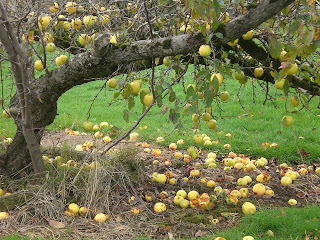Fleece Sale
On November 14th Melinda, Peggy and I traveled I-5 from Edmonds through the Skagit Valley to Burlington and our destination: Jonnasson's Farm for the annual fleece sale there.

 We didn't stop for Alpaca.
We didn't stop for Alpaca.You would think we would have
but perhaps some other time.
 We didn't stop for cider either.
We didn't stop for cider either.I've been looking for Dorset roving ever since. It's not available. Not at Black Sheep, not at OFFF, not at Whidbey Spin-in, not at Madrona, all fiber conferences with large, if not huge, markets. So then I figured I'd have to find a fleece, since my search began prior to jumping in to the 'fresh off the sheep' part of spinning. No luck at any of the fiber conferences for fleece either, but then, finally, Gretchen at Gretchens Wool Mill gave us a lead to this fleece sale which the Hordyks of Sand Hill Farm are part of and and they raise Dorsets and would have some available, which we knew because we called to make sure. yea! We've been looking forward to this for a month.
to the North Cascades Highway.
North Cascades Highway is a worthwhile road trip
if it's not winter.
 Although I suspected we did one,
Although I suspected we did one,I was assured that no U-Turns happened this trip.
 The Jonnassons farm building
The Jonnassons farm buildingwhich housed the fleece sale.
 There was fiber and fleece available,
There was fiber and fleece available,dyed and natural.


 Eileen Hordyk shows Peggy the crimp in
Eileen Hordyk shows Peggy the crimp ina brown Dorset/Rambouilett cross fleece.
 Melinda weighing the pros and cons
Melinda weighing the pros and consbetween two brown Rambouilett/Dorset cross fleeces.
One was darker, a ram fleece and 7lbs;
the other was lighter, from a ewe and 6lbs.
We took the 6 pounder and
will have it washed before we split it three ways.
It was only $24.00.
 Peggy bought some Mohair.
Peggy bought some Mohair. The Dorset fleece.
The Dorset fleece. This turned out to be the only one at the sale.
Of course I had to buy it ~ it was only $18.00. For 6 pounds.
After washing I should have at least 3 pounds,
enough to spin for a sweater.
 6lbs of Dorset Ewe #1011
6lbs of Dorset Ewe #1011 Like Sams, it was very filthy
Like Sams, it was very filthybut also very crimpy.
 Eileen, who owns the ewe this fleece came from,
Eileen, who owns the ewe this fleece came from,showed me how to remove the damaged tips before washing.
So when we arrived home I immediately worked with
a little of the fleece because why wait?
 This is rinsed just once in hot water.
This is rinsed just once in hot water. And here it is washed one time with Dawn and hot water.
And here it is washed one time with Dawn and hot water. Through the carder once.
Through the carder once. Spun and 2-plied.
Spun and 2-plied.It's bouncy and cushy. This will be great!

some of the Jonnassons Fleece on the Hoof.






